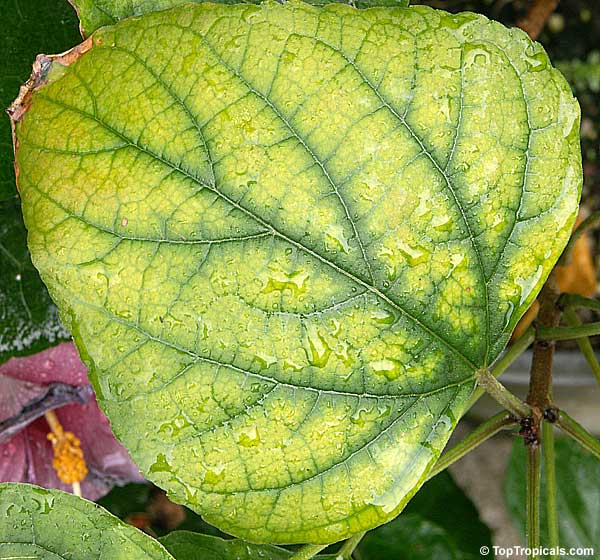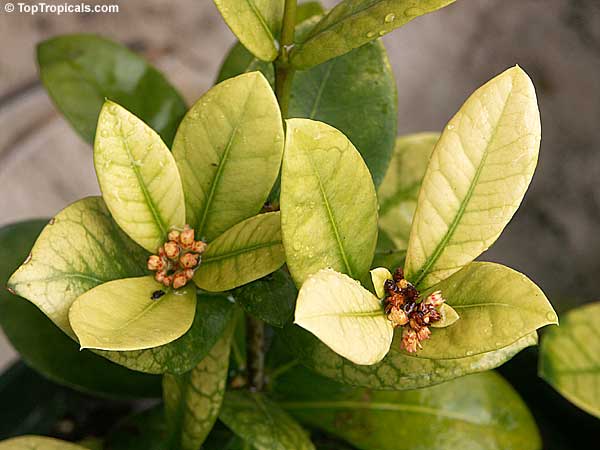Micronutrients Mix
See also: Essential Nutrients
Plants need food for their growth. While macronutrients (nitrogen, phosphorous, potassium, etc.) are present in all ready-to-use fertilizers (N-P-K ratio), microelements (iron, boron, etc) are often missing in the mix or unavailable to plants.
The most common problem with potted plants is iron deficiency. Iron (Fe) is
ranked fourth in abundance after oxygen, silicon and aluminium in the earth's
crust. Yet, as far as plant nutrition is concerned, it is classified as a micronutrient,
or trace element, as it is only required in small amounts. There are many reasons
why iron (being in concentration up to 2.5% in soil) is unavailable to plants.
For example, peat moss, widely used in potted soil mix, ties up iron and other
micronutrients. The ability of roots to absorb iron is reduced by poor root health
caused by inadequate soil aeration resulting from excess watering. Iron can be
oxidized very quickly without chelating agent, such as EDTA.
 The symptom of iron deficiency is chlorosis or yellowing between
the veins of the youngest leaves, while older leaves remain green. This allows
iron deficiency to be distinguished from magnesium deficiency (see below). Usually
there is a sharp distinction between the yellow chlorotic tissue and the green
veins. That distinguishes iron deficiency from zinc and manganese deficiencies
in which color changes gradually. In severe cases, the yellowing runs into the
veins and the whole leaf turns yellow or even white.
The symptom of iron deficiency is chlorosis or yellowing between
the veins of the youngest leaves, while older leaves remain green. This allows
iron deficiency to be distinguished from magnesium deficiency (see below). Usually
there is a sharp distinction between the yellow chlorotic tissue and the green
veins. That distinguishes iron deficiency from zinc and manganese deficiencies
in which color changes gradually. In severe cases, the yellowing runs into the
veins and the whole leaf turns yellow or even white.Foliar sprays are the preferred way to apply iron in case of iron deficiency.
Soil applications may be ineffective if factors, restricting uptake of iron from
the soil, are present.
We offer our own micronutrients mix. It should be used as a supplemental spray,
not as fertilization replacement. The mix increases the growth and quality of
virtually every plant, grown indoors or out.
This deficiency results in stunted growth of young plants. The youngest leaves are affected first. They will be misshapen, thick, brittle and small. Because boron is not easily transferred from old to young leaves, older leaves usually remain green and appear healthy. Often dark brown, irregular lesions appear, followed by pale yellow chlorosis of young leaves. Stems are short and growing points may die.
Cu Copper 0.1% Young leaves dark green and misshapen, curling into a tube, petioles bent downward, few or no flowers. Copper is not readily transferred from old to young leaves, so older leaves remain darker and relatively healthy and the deficiency symptoms develop on younger leaves. Fe Iron 7% Chlorosis of the younger leaves characterizes an iron deficiency. The tissue between the veins gradually turns yellow, while the veins tend to stay green. The tips and margins of some leaves may turn brown and become dry and brittle Mn Manganese 2% Deficiency symptoms include pale green young leaves and a pale yellow mottling develops in interveinal areas, while the veins remain green. White to grey flecks or specks first appear and become more severe on mature leaves about halfway up the shoot. If a deficiency persists, symptoms spread to old leaves then to the youngest leaves. Mo Molybdenum 0.06% Since molybdenum deficiencies are very uncommon symptoms are rarely seen. Zn Zinc 0.4% Puckered margins on leaves, brown spots on petioles, small leaves, sometimes long and narrow EDTA This is not a plant nutrients. It's added to the mix as chelating agent to incorporate metal ions into a soluble but bound form and to make them available to the plant.The dry mix has very long shelf life when kept in dry, dark location. The solution has life of about month and should be kept in dark (element-EDTA bond brakes down under light very quickly)
Usage
To correct iron deficiency: mix 1/2 - 1 teaspoon (2.5-5 g) per gal of water. Spray plant every 2-3 days. Reduce dose for annual and tender plants. If your water is alkaline (high calcium content) do not use it. Use distilled water sold in supermarkets (not spring water).
To use as plant supplement: mix 1/4 teaspoon (1 g) per gal of water. Spray plant every week or two weeks during growth period. Reduce dose for annual and tender plants.
Do not overfertilize the plants. In high concentration micronutrients could
be toxic for plants. It is best to test a foliar spray on a few plants/leaves
and wait several days to observe the effects. It's always better to use smaller
concentration.


